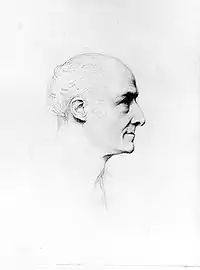
John Samuel Agar (1773–1858) was an English portrait painter and engraver, who exhibited his works at the Royal Academy from 1796 to 1806[1] and at the British Institution until 1811. He did not exhibit again until 1836.[2] He had been declared bankrupt in February of the previous year.[3]
He was at one time president of the Society of Engravers. His engravings were chiefly in stipple.[1] They include works after Richard and Maria Cosway, and a series of allegories of the months after Edward Francis Burney, published by Rudolf Ackermann in 1807–9.[2] His illustrations for Richard Payne Knight's Specimens of Ancient Sculpture, Aegyptian, Etruscan, Greek and Roman: Selected from different collections in Great Britain (1809), have been described by Nicholas Penny as "the finest ever made of sculpture".[2]
Notes
- 1 2 Bryan
- 1 2 3 "Drawing (Self-portrait of John Samuel Agar)". British Museum. Retrieved 15 October 2012.
- ↑ "Bankruptcies" (PDF). London Gazette. Retrieved 15 October 2012.
References
 This article incorporates text from a publication now in the public domain: Bryan, Michael (1886). "Agar, John Samuel". In Graves, Robert Edmund (ed.). Bryan's Dictionary of Painters and Engravers (A–K). Vol. I (3rd ed.). London: George Bell & Sons.
This article incorporates text from a publication now in the public domain: Bryan, Michael (1886). "Agar, John Samuel". In Graves, Robert Edmund (ed.). Bryan's Dictionary of Painters and Engravers (A–K). Vol. I (3rd ed.). London: George Bell & Sons.
External links
- National Portrait Gallery Profile
 Media related to John Samuel Agar at Wikimedia Commons
Media related to John Samuel Agar at Wikimedia Commons